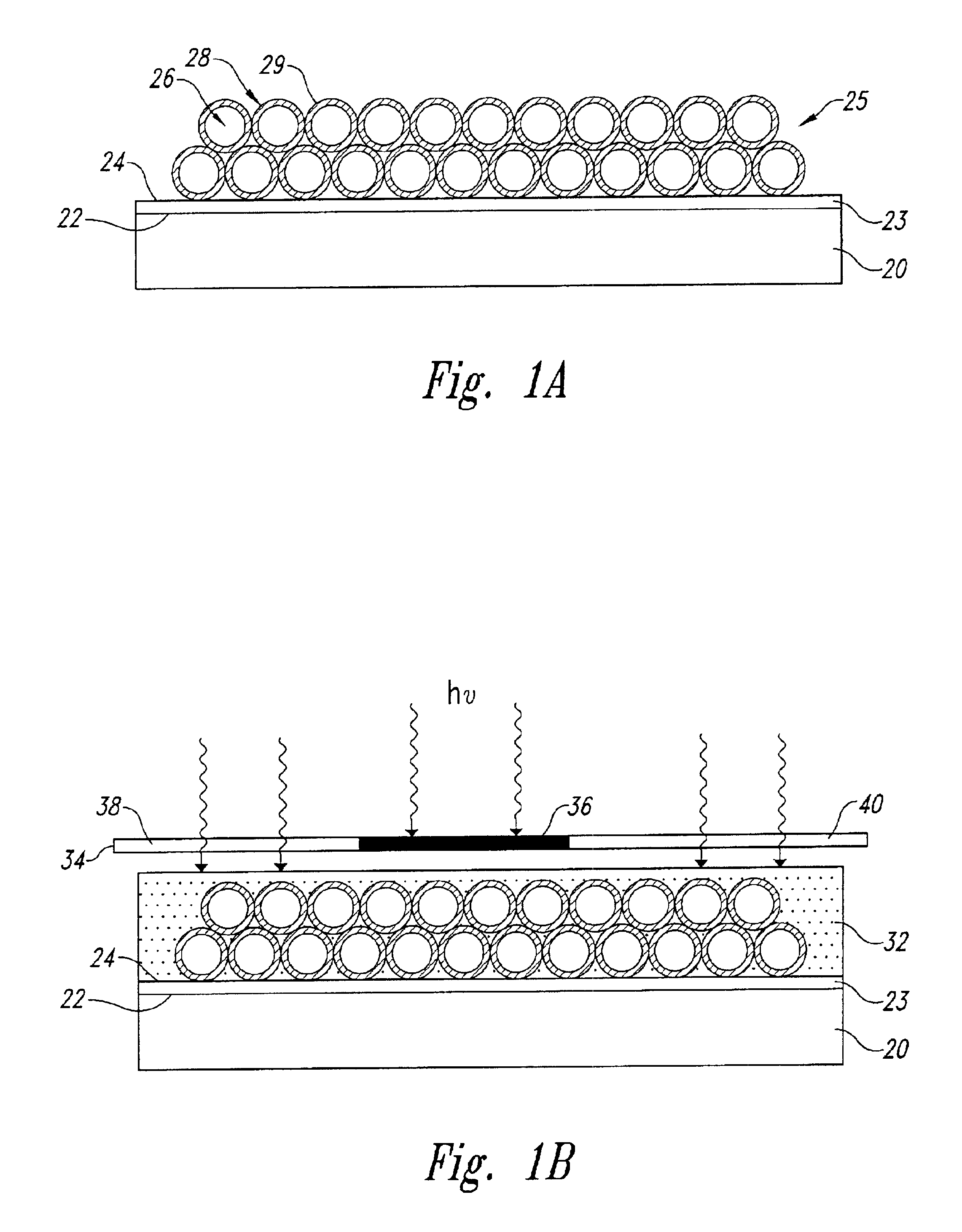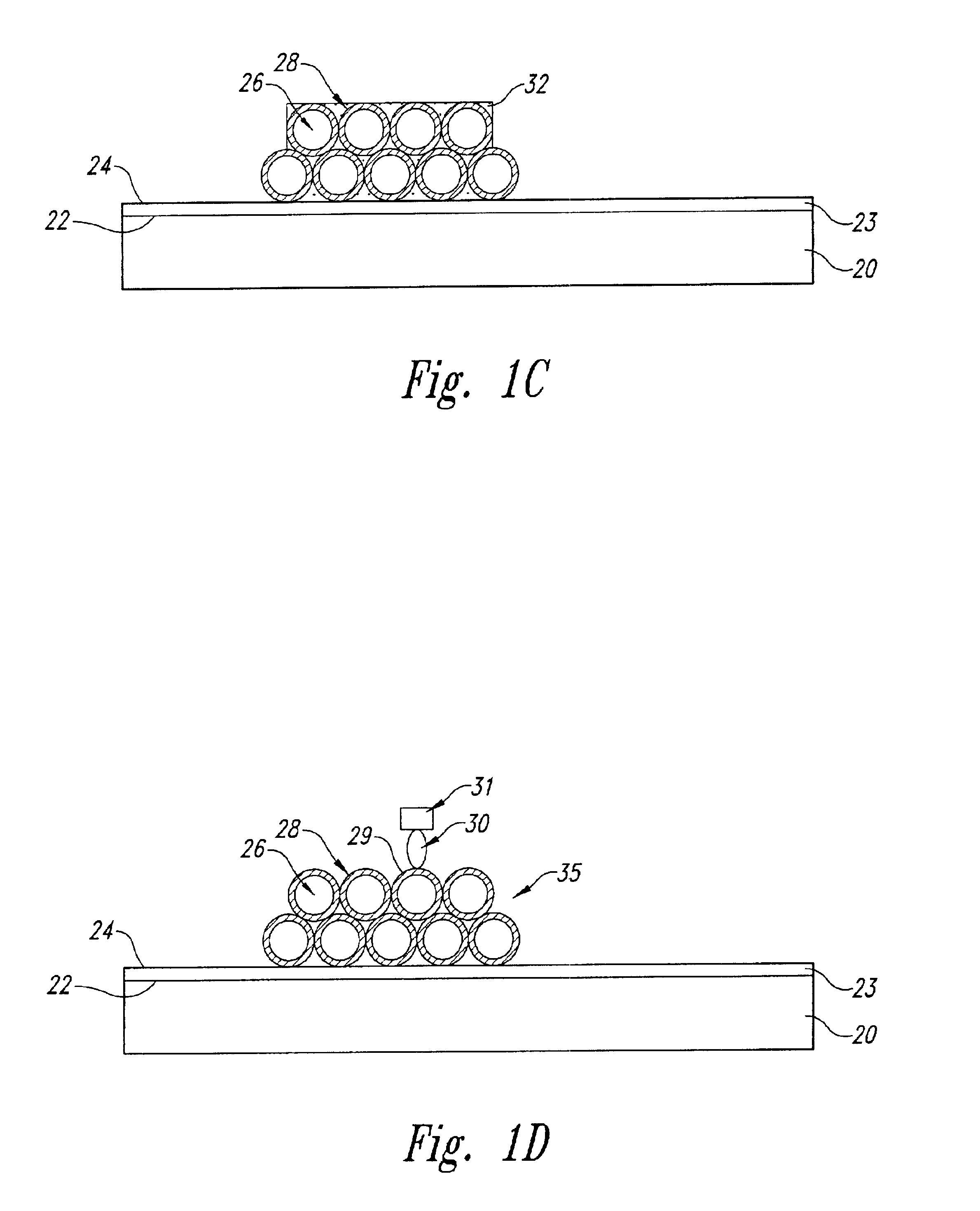Porous coatings bearing ligand arrays and use thereof
a technology of porous coatings and ligand arrays, applied in the direction of sugar derivatives, library creation, and sequential/parallele process reactions, can solve the problems of increasing surface density, requiring costly imaging equipment, and long image acquisition time,
- Summary
- Abstract
- Description
- Claims
- Application Information
AI Technical Summary
Benefits of technology
Problems solved by technology
Method used
Image
Examples
example 1
Attachment of an Adhesive Layer
[0297]This Example describes the attachment of an adhesive layer to a glass substrate, prior to application of a porous coating.
[0298]An adhesive layer was prepared on a commercial glass microscope slide (Curtin-Matheson Scientific, Inc., Houston, Tex.). The adhesive layer was prepared from a clear sol obtained by hydrolyzing and aging tetraethoxysilane (Aldrich Chemical Company, Inc., Milwaukee, Wis.). To prepare the sol, a concentrated sol was first prepared by hydrolyzing 21.7 ml of tetraethoxysilane in 6.3 ml H2O and 0.7 ml IN nitric acid at room temperature for approximately 1 hour, followed by aging at 4° C. for several days. The concentrated sol was diluted 50-fold with ethanol, and applied to one surface of the slide at an incline using a pipette. The solvent was allowed to evaporate at room temperature leaving an adhesive layer less than 1 μm thick, and a free adhesive surface. The layer was cured by placing the slide on a heating block at 110...
examples 2-8
Preparation of Representative Porous Coatings
[0299]These Examples describe the preparation of representative porous coatings.
[0300]The porous coating was obtained from a liquid coating solution. The coating solutions were prepared as follows: Five grams of fumed silica (SiO2) with a primary particle size of 500 Å (Degussa, Inc., Ridgefield Park, NJ) were dispersed in 100 ml of 95% ethanol (5% water). To this dispersion was added tetraethoxysilane (TEOS) monomer or polymer in an amount indicated in Table VIII. TEOS polymer was obtained as described in Example 1. Sufficient nitric acid was added to provide an acidity of from 2.0 to 4.2 pH units. Coating solutions that incorporated linker molecules further included 3-aminopropyltriethoxysilane (i.e., “APES”, from Aldrich Chemical Company, Inc., Milwaukee, Wis.) or bis(2-hydroxyethyl)-3-aminopropyltriethoxysilane (i.e., “HAPES”, from Gelest, Inc., Tullytown, Pa.) in amounts as indicated in Table VIII. The coating solutions thus formed w...
examples 9-18
Comparative Coatings
[0303]These Examples illustrate the preparation of coatings in a manner similar to those in Examples 2-8, with modifications as summarized in Table IX. The coating solutions were applied to the adhesive surface of glass slides prepared as in Example 1, producing substantially uniform liquid layers. The liquid layers were allowed to evaporate at room temperature followed by curing at 120° C. for 15 minutes. The series of coatings were evaluated with respect to film quality as reported in Table IX.
[0304]
TABLE IXLinker,ExampleTEOS,TEOSμmole / gAge ofMajorityFilmNumberμmole / g silicapolymerizedsilicapHMixSolventQuality9————NAethanolseparated10————NAwatercracked11————NA3-pentanoneseparated121860no—2.8 3-pentanoneflocculated13744yes—4.2 ethanolseparated14240no—>10>24 hrsethanolclumped15——APES, 604.1>24 hrsethanolflocculated16180noHAPES, 604.0>24 hrsethanolclumped17180yesAPES, 604.1>24 hrsethanolclumped18180noAPES, 604.2 18 hrsethanolseparated1NA - not applicable.
[0305]A...
PUM
| Property | Measurement | Unit |
|---|---|---|
| Temperature | aaaaa | aaaaa |
| Temperature | aaaaa | aaaaa |
| Fraction | aaaaa | aaaaa |
Abstract
Description
Claims
Application Information
 Login to View More
Login to View More - R&D
- Intellectual Property
- Life Sciences
- Materials
- Tech Scout
- Unparalleled Data Quality
- Higher Quality Content
- 60% Fewer Hallucinations
Browse by: Latest US Patents, China's latest patents, Technical Efficacy Thesaurus, Application Domain, Technology Topic, Popular Technical Reports.
© 2025 PatSnap. All rights reserved.Legal|Privacy policy|Modern Slavery Act Transparency Statement|Sitemap|About US| Contact US: help@patsnap.com



